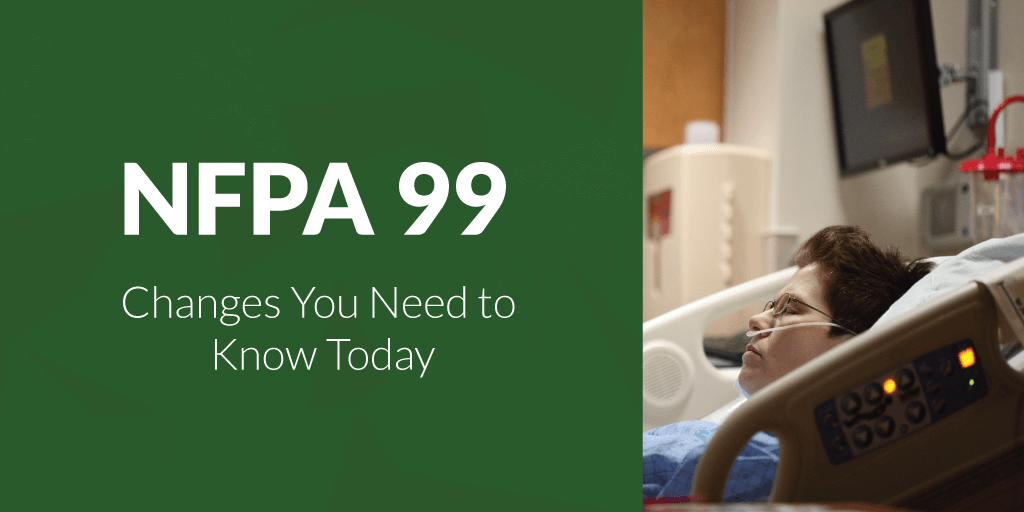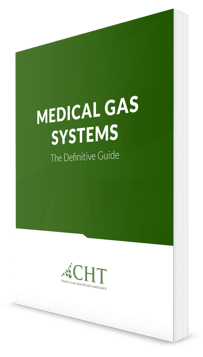
NFPA 99: Healthcare Facilities Code provides safety guidelines for healthcare facilities. The main objective of the code is to ensure that healthcare facilities are up-to-date and safe for their occupants.
The code follows a risk-based approach, where it is the risk posed to patients, staff, or visitors that defines safety guidelines.
As a leader in the control, management, and monitoring of medical gas systems, CHT is asked frequently regarding NFPA 99: Healthcare Facilities Code,
"What Applies to My Facility?"

Understanding NFPA codes can leave facility managers scratching their heads. Requirements are not always black and white. Determining which edition of the NFPA code applies to your facility can be frustrating.
Moreover, once the correct interpretation of the code has been established, there is still the question of its application to your individual scenario. Risk assessments must be performed to determine the correct category and level of care provided and the corresponding application.
Applying NFPA 99 varies depending on the level of care required and provided.
The Recent History of the NFPA 99
Since July 5, 2016, the Centers for Medicare and Medicaid Services (CMS) has adopted the 2012 edition of NFPA 99. From a medical gas compliance perspective, this is the edition to which facilities are held accountable.
However, since NFPA 99 is not intended to be a retroactive code, only select portions of NFPA 99-2012 shall apply to systems existing prior to the July 5, 2016 adoption. Specifically, the inclusion of NFPA 99-2012 Tentative Interim Amendment (TIA) 12-4 outlines the sections that apply to both new and existing construction.
Similarly, much of the criteria in TIA 12-4 can also be found in The Joint Commission Hospital Accreditation Standard, EC.02.05.09. It should be noted, however, that individual authorities having jurisdiction (AHJs) are permitted to adopt subsequent editions of NFPA 99 for the purposes of new construction.
Annual Evaluation of Medical Gas System
When performing an annual evaluation of your medical gas system, knowing which sections of NFPA 99 apply is important. This will require a thorough understanding of your risk category, as well as historical knowledge of your facility, since any pipeline alterations, renovations, or modernizations may impact the application.
For example, if an older facility had part of a system remodeled and the pipeline is breached, the area in the immediate vicinity would need to be installed to the most recently adopted edition of NFPA 99 for that jurisdiction.
Conversely, the older portions of the systems not meeting the 2012 edition may still be acceptable to the AHJ as long as their continued use does not present a distinct hazard to life. In either scenario, a comprehensive understanding of your facility and its relationship with NFPA 99 is vital.
Knowing which sections of your facility may require upgrades can be beneficial for infrastructure budgeting and ensuring the smooth operation of your medical gas system for years to come.
NFPA 99 HealthCare Facilities Code - 2018 Edition
Changes in the 2018 edition help you work more efficiently to ensure healthcare safety.
Here are some of the details that will be required under the NFPA 99-2018 code that are different from earlier versions.
1. Oxygen Concentrators
Chapter 5 includes requirements that now allow for the use of oxygen concentrators as central supply sources for piped medical gas systems.
5.1.3.5.11.1 states Oxygen Concentrator Supply Units for use with medical gas pipelines shall produce oxygen meeting the requirements of Oxygen 93 USP or Oxygen USP.
What it means...
The 2018 edition adds requirements for onsite oxygen production by a concentrator. Oxygen concentrators are and continue to be, limited in use for most facilities in the United States. Remote areas, such as Hawaii, Alaska, and other island territories implementing NFPA 99 will now have some guidance on their use.
Background on why that change has been made...
The technology behind these supply sources is nothing new and their use has previously been part of the ISO Standard, but is now addressed by NFPA.
How the change may impact the present or future design of medical gas and vacuum systems...
Ultimately, this addition to the 2018 code will have little to no impact on most facilities within the United States since a majority of hospitals are supplied by a traditional cryogenic fluid central supply system (previously referred to as a bulk cryogenic liquid system).
2. Vacuum Filtration
The detailed requirements for vacuum filtration are defined in the code. The filters are required to be as efficient as HEPA (0.3μ (microns) and 99.97% high efficiency).
What it means...
Medical-Surgical Vacuum Central Supply Systems now require inlet filtration on the patient side of the vacuum producer.
Background on why that change has been made...
While the science is still out and more data is required, there has been a concern that infectious or other hazardous materials may be transmitted from the patient terminal back to the supply source.
The addition of this filtration is to alleviate some of those potential concerns.
How the change may impact the present or future design of medical gas and vacuum systems...
Manufacturers will need to incorporate these filtration requirements into the design of their new vacuum systems.
3. Corrugated Medical Gas Tubing
5.1.10.1.4 Corrugated medical tubing (CMT) is now a permitted material for medical gas and vacuum systems.
What it means...
The additional inclusion of corrugated medical tubing will allow installers another piping option, particularly for difficult installations. Ease of installation, reduced cost, and less chance of contamination are benefits that are invaluable for healthcare facilities. CMT is a fabricated tubing with flexibility making it ideal for retrofits and new construction.
Kevin Hoben, OmegaFlex® CEO, a global manufacturer of metal hoses, says
"Copper tubing has always been costly to install with countless brazed sections that make a system vulnerable to leaks and contamination. MediTrac comes in one, long length to eliminate hot work, and its unique design makes it easy to bend as needed to fit a space."
MediTrac is fully compliant with NFPA 99 (2018) code.
Background on why that change has been made...
This is a new technology for medical gas piping.
How the change may impact the present or future design of medical gas and vacuum systems...
Corrugated medical tubing's usage can be beneficial, particularly for the installation of positive pressure piping in pre-existing construction. It can reduce the number of installed joints and aid in installations where space or brazed joints can be difficult.
How to implement the change...
Contact your installer to see if CMT tubing would be beneficial to your next project.
4. The Addition of Chapter 15: Dental Gas and Vacuum Systems
This chapter was added specifically to dental gas and vacuum systems to address their precise needs.
What it means...
With the previous changes to NFPA 99, particularly as it relates to the change from an occupancy-based document to a risk-based standard, there were some issues with requirements for dental facilities, which were historically addressed as a Category 3 system.
Background on why that change has been made...
Since Category 1 procedures can be performed in a dental setting, the need for an expanded chapter was necessary. Now, within a dental setting, NFPA addresses Categories 1-3.
How the change may impact the present or future design of medical gas and vacuum systems...
This change will allow for a more detailed understanding and implementation of NFPA 99 for all manner of dental system installations.
5. "Governing Body" Wording
In addition, we are seeing a global change in the 2018 edition.
The term "governing body" is changed to "healthcare facility's governing body". This is to help clarify or highlight the intent. Governing body represents the people who are responsible for the operation of the healthcare facility.
NFPA 99: HealthCare Facilities Code - 2021 Edition
The 2021 edition delivers the foundation for building risk-based performance criteria for the healthcare facility's environment.
While there is no current indication the 2021 edition will be adopted by the Centers for Medicare & Medicaid Services (CMS), some of the updates highlight the importance of having qualified individuals managing and maintaining medical gas systems.
1. Responsible Facility Authority (RFA)
With the newer edition, the RFA role will encompass a more prominent look into the operational management of the medical gas and vacuum systems.
The RFA will:
- Be solely responsible for keeping all the documentation
- Issuing permit-to-work on a medical gas system
- Fulfill the obligations in 5.1.14.1.2.2
5.1.14.1.2.2 states that "the responsibility of the RFA is to be able to advise on the code issues regarding risk assessments related to categories of care and all content in the NFPA 99 sections 5.1 through 5.3 regarding medical gas systems code for category 1,2, and 3 facilities."
With its increasing demand in nature, the position requires a high level of competency.
2. Permit-to-Work System
The inclusion of a documented Permit-to-Work system in the code is a step forward in providing a safe and efficient method of performing routine maintenance, repairs, and medical gas system installations by ensuring proper communication and protocols are being adhered to by facility staff.
In addition to shutdown procedures, the Permit-to-Work system shall require proper testing on affected portions of the medical gas system after any work is performed to effectively “close the loop.”
3. New Requirements for the Emergency Oxygen Supply Connection
From a design perspective, the Emergency Oxygen Supply Connection (EOSC) is now required to include master alarm connection points to monitor the temporary supply of oxygen. NFPA 99 has always applied to all medical gas installations, including temporary installations.
However, monitoring a temporary supply of oxygen has previously been difficult since additional, often temporary, wiring was needed to be installed prior to connection to the EOSC. In a real emergency, installing this wiring was unlikely, and unfortunately, the system was not adequately monitored. This addition rectifies this condition moving forward.
Conclusion
NFPA 99 2012 edition is currently adopted by the federal government at the time of this writing.
While these are just a few of the changes and updates to NFPA 99, the document continues to evolve with the ever-changing world of healthcare to provide a safe environment for patients, staff, and visitors.
And even more changes will be forthcoming in the NFPA 99: Healthcare Facilities Code edition - 2024 edition.
As these codes develop, CHT will keep you informed.
For help in determining how to apply NFPA 99 to your facility, contact your CHT representative today. Our knowledgeable staff can assist in navigating through NFPA 99.




